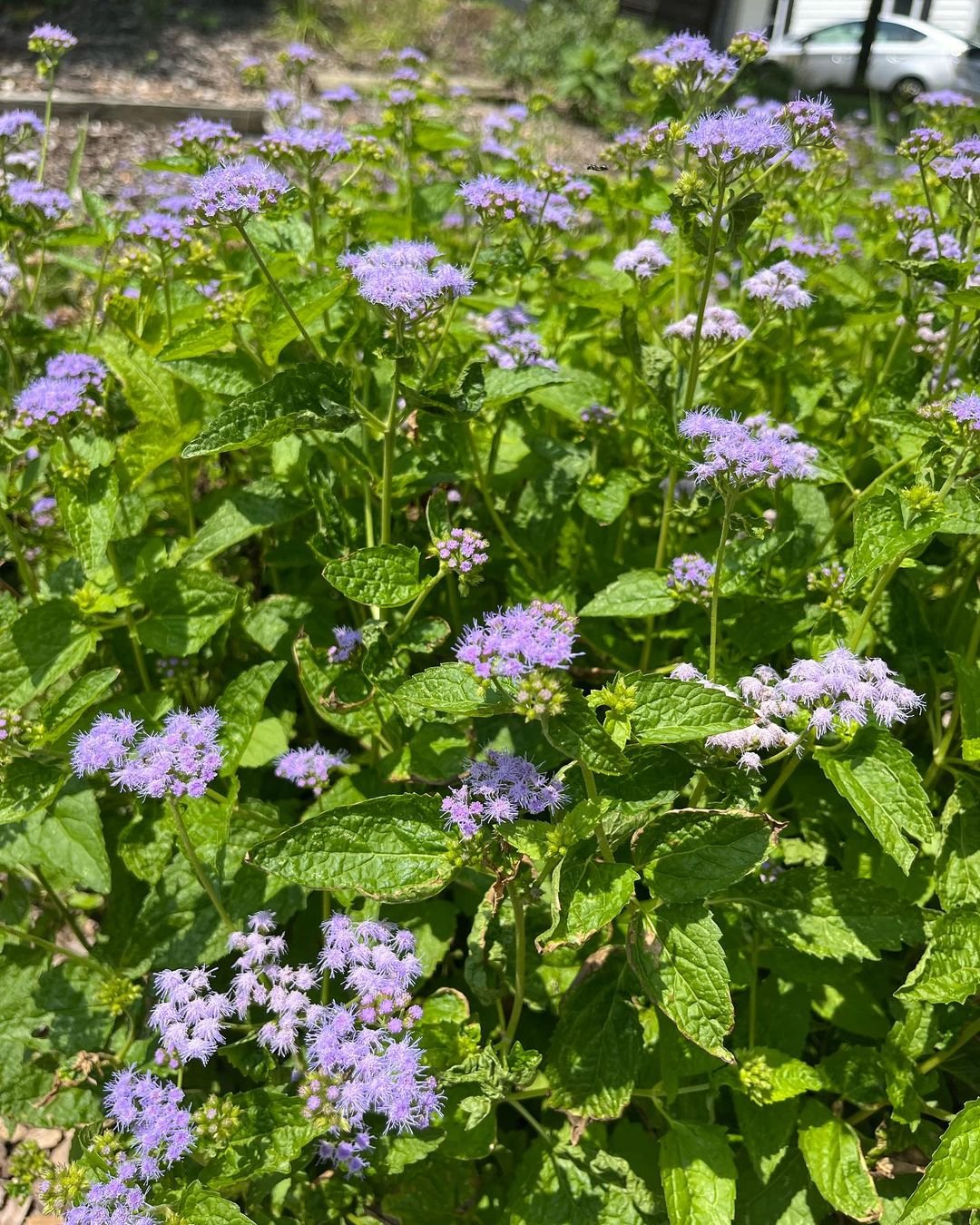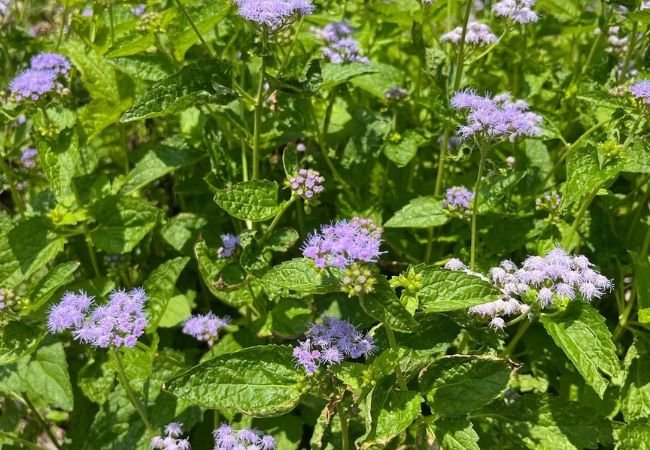Get the ultimate guide to growing Blue Mistflower. Discover planting tips, care instructions and how to maximize its vibrant blooms.
Are you looking to add a splash of vibrant color and ethereal beauty to your garden? Look no further than the Blue Mistflower. This stunning perennial, with its cloud-like clusters of blue flowers, can transform any landscape into a dreamy, pollinator-friendly paradise. In this comprehensive guide, we’ll explore everything you need to know about growing and caring for Blue Mistflower, from planting to pruning and beyond. Get ready to elevate your garden with this captivating and easy-to-grow plant!
Here’s a chart with information about the Blue Mistflower (Conoclinium coelestinum):
| Category | Information |
|---|---|
| Botanical Name | Conoclinium coelestinum |
| Common Name | Blue Mistflower |
| Plant Type | Herbaceous perennial |
| Hardiness Zone | USDA Zones 5-9 |
| Sun Exposure | Full sun to part shade |
| Soil Type | Well-draining |
| Watering | Moderate |
| Growth Habit | Clumping, spreading |
| Height/Spread | 1-3 feet tall, 1-2 feet wide |
| Special Features | Clusters of small, fuzzy, blue-purple flowers, attracts butterflies and bees, deer resistant, good for naturalizing, blooms late summer to fall |
What is Blue Mistflower?

Before we dive into care tips, let’s get acquainted with this charming plant. Blue Mistflower (Conoclinium coelestinum), also known as hardy ageratum or blue boneset, is a native North American perennial that belongs to the aster family. It’s prized for its fluffy clusters of small, blue-purple flowers that bloom from late summer through fall, creating a misty, cloud-like effect in the garden.
This delightful plant gets its name from the soft, hazy appearance of its flower clusters, which seem to float above the foliage like a gentle mist. Since its discovery, it has become a favorite among gardeners for its low maintenance requirements, long blooming period, and ability to attract pollinators.
Key Features of Blue Mistflower:
- Height: Typically grows 1-3 feet tall
- Spread: Can spread 1-3 feet wide
- Bloom time: Late summer to fall
- Flower color: Pale blue to lavender-blue
- Foliage: Dark green, serrated leaves
- Attracts pollinators: Butterflies, bees, and other beneficial insects love the nectar-rich blooms
Now that we’re familiar with this beautiful plant, let’s explore how to make it thrive in your garden.
Planting Blue Mistflower
Proper planting is crucial for the long-term health and success of your Blue Mistflower. Follow these steps to give your plant the best start:
- Choose the right location: Blue Mistflower prefers full sun to partial shade. In hotter climates, some afternoon shade can be beneficial.
- Prepare the soil: This plant adapts to various soil types but thrives in moist, well-draining soil. Aim for a slightly acidic to neutral pH (6.0-7.0). If needed, amend your soil with organic matter to improve drainage and fertility.
- Dig the hole: Make it twice as wide as the root ball and just as deep. This encourages roots to spread outward.
- Plant at the right depth: The top of the root ball should be level with the soil surface.
- Backfill and water: Gently fill in around the roots with soil, tamping down to remove air pockets. Water thoroughly after planting.
- Mulch: Apply a 2-3 inch layer of organic mulch around the base, keeping it away from the stem to prevent rot.
Caring for Your Blue Mistflower
Once your Blue Mistflower is in the ground, it’s time to nurture it to its full potential. Here are essential care tips to ensure your plant thrives:
Watering
Blue Mistflower prefers consistently moist soil but can tolerate short periods of drought once established. Follow these watering guidelines:
- Water deeply and regularly during the first growing season to establish a strong root system.
- Once established, provide about 1 inch of water per week, either from rainfall or irrigation.
- Use a soaker hose or drip irrigation for efficient watering.
- Avoid overhead watering to prevent fungal diseases.
Fertilizing
Blue Mistflower isn’t a heavy feeder, but periodic fertilization can promote healthy growth and abundant blooms:
- Apply a balanced, slow-release fertilizer in early spring as new growth emerges.
- Use a fertilizer with an NPK ratio of 10-10-10 or similar.
- Avoid over-fertilizing, as this can lead to excessive growth and reduced flowering.
Pruning
Pruning is essential for maintaining the shape and health of your Blue Mistflower:
- Cut back stems to about 4-6 inches above ground level in late winter or early spring before new growth begins.
- Pinch back stem tips in late spring to encourage bushier growth and more flowers.
- Deadhead spent blooms throughout the growing season to encourage more flowers and prevent self-seeding.
Pest and Disease Management
Blue Mistflower is generally resistant to pests and diseases, but it’s always good to be vigilant:
- Watch for common pests like aphids or spider mites.
- If pests appear, try hosing them off with a strong stream of water or using insecticidal soap.
- Prevent fungal diseases by ensuring good air circulation and avoiding overhead watering.
Landscaping with Blue Mistflower
Now that you know how to care for your Blue Mistflower, let’s explore some creative ways to incorporate it into your landscape:
- Wildflower gardens: Its native status makes it perfect for naturalistic plantings.
- Butterfly gardens: The nectar-rich flowers are irresistible to butterflies and other pollinators.
- Cottage gardens: The soft, cloud-like blooms add a whimsical touch to informal garden designs.
- Rain gardens: Blue Mistflower’s preference for moist soil makes it an excellent choice for rain gardens.
- Border plantings: Use as a mid-height border plant in mixed perennial beds.
- Mass plantings: Create a stunning display by planting in large drifts.
- Container gardening: Grow in large containers for patios or balconies.
Companion Plants for Blue Mistflower
To create a harmonious and visually appealing landscape, consider pairing your Blue Mistflower with these complementary plants:
- Black-Eyed Susan (Rudbeckia hirta): These vibrant yellow flowers contrast beautifully with the blue blooms of Mistflower.
- Joe-Pye Weed (Eutrochium purpureum): This tall native perennial complements Blue Mistflower in both color and form.
- Goldenrod (Solidago spp.): These yellow blooms create a stunning contrast with Blue Mistflower.
- New England Aster (Symphyotrichum novae-angliae): Another late-blooming native that pairs well with Blue Mistflower.
- Switchgrass (Panicum virgatum): This native grass adds texture and movement to complement the soft blooms of Blue Mistflower.
Seasonal Interest of Blue Mistflower
One of the many charms of Blue Mistflower is its seasonal appeal. Here’s what you can expect throughout the year:
- Spring: New growth emerges, with fresh green foliage.
- Summer: The plant continues to grow, developing into lush mounds of green.
- Fall: Abundant blue-purple flowers bloom, creating a misty haze in the garden.
- Winter: While the plant dies back to the ground, it can provide winter interest through its seed heads if left standing.
Propagating Blue Mistflower
If you’ve fallen in love with your Blue Mistflower and want more, good news – it’s easy to propagate! Here are two methods:
Division
In early spring, dig up the entire plant.
Gently separate the root ball into smaller sections, each with several shoots.
Replant the divisions immediately and water well.
Stem Cuttings
In early summer, take 4-6 inch cuttings from non-flowering stems.
Remove lower leaves and dip the cut end in rooting hormone.
Plant in a well-draining potting mix and keep moist.
Roots should develop in 3-4 weeks.
Blue Mistflower in Different Climates
Blue Mistflower is native to the eastern and central United States, but it can adapt to various climates:
- Cold climates (USDA zones 5-6): Provide winter protection with a layer of mulch. The plant will die back to the ground but regrow in spring.
- Temperate climates (USDA zones 7-8): Ideal conditions for Blue Mistflower. It will thrive with minimal care.
- Warm climates (USDA zones 9-10): Provide afternoon shade and ensure consistent moisture to prevent heat stress.
Troubleshooting Common Issues
Even with the best care, you might encounter some challenges with your Blue Mistflower. Here are some common issues and how to address them:
- Leggy growth: This often results from insufficient light. Prune back leggy stems and consider relocating the plant to a sunnier spot.
- Powdery mildew: Improve air circulation and avoid overhead watering. If necessary, treat with a fungicide.
- Spreading too aggressively: Install root barriers or regularly divide the plant to control its spread.
- Leaf spot: Remove affected leaves and improve air circulation. Avoid overhead watering.
Environmental Benefits of Blue Mistflower
Beyond its ornamental value, Blue Mistflower offers several environmental benefits:
- Supports pollinators: Provides nectar for butterflies, bees, and other beneficial insects.
- Native plant: As a native species, it supports local ecosystems and wildlife.
- Erosion control: Its spreading root system helps prevent soil erosion.
- Low water needs: Once established, it’s relatively drought-tolerant, making it a good choice for water-wise gardens.
Blue Mistflower in Floral Arrangements
While primarily grown as a garden plant, Blue Mistflower can also be used in floral arrangements:
- Cut stems in the morning when flowers are fully open.
- Place immediately in water and remove any foliage that will be below the water line.
- Use in mixed bouquets for a soft, cloud-like effect.
- Note that the vase life is relatively short, typically 3-5 days.
Blue Mistflower is a versatile, low-maintenance perennial that can add a touch of whimsy and vibrant color to any garden. With its cloud-like blue blooms, pollinator-friendly nature and easy care requirements, it’s an excellent choice for gardeners of all skill levels. By following these planting tips, care instructions and creative landscaping ideas, you’ll be well on your way to creating a thriving, beautiful garden that you can enjoy from late summer through fall.
Remember, the key to success with Blue Mistflower lies in providing the right growing conditions, consistent care and a little bit of creativity in your landscape design. So go ahead, give this charming native plant a try and watch as it transforms your outdoor space into a dreamy, pollinator-friendly paradise that you and local wildlife will love!








Leave a Reply